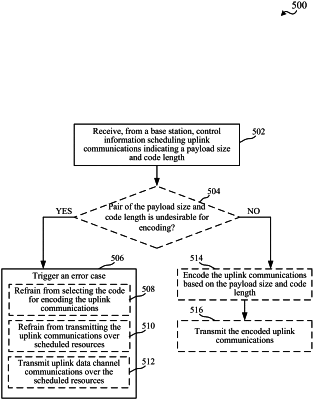| CPC H04W 72/21 (2023.01) [H04L 1/0068 (2013.01); H04L 1/0071 (2013.01); H04W 72/0466 (2013.01); H04W 72/1268 (2013.01); H04W 72/535 (2023.01)] | 30 Claims |

|
1. An apparatus for wireless communication, comprising:
a transceiver;
a memory configured to store instructions; and
one or more processors communicatively coupled with the memory and the transceiver, wherein the one or more processors are configured to:
receive, from a base station, control information scheduling uplink communications, wherein the control information indicates a payload size and a code length for encoding the uplink communications based on a code; and
trigger an error case where a pair of the payload size and the code length is considered undesirable for performing the encoding,
wherein triggering the error case includes refraining from transmitting the uplink communications over scheduled resources.
|